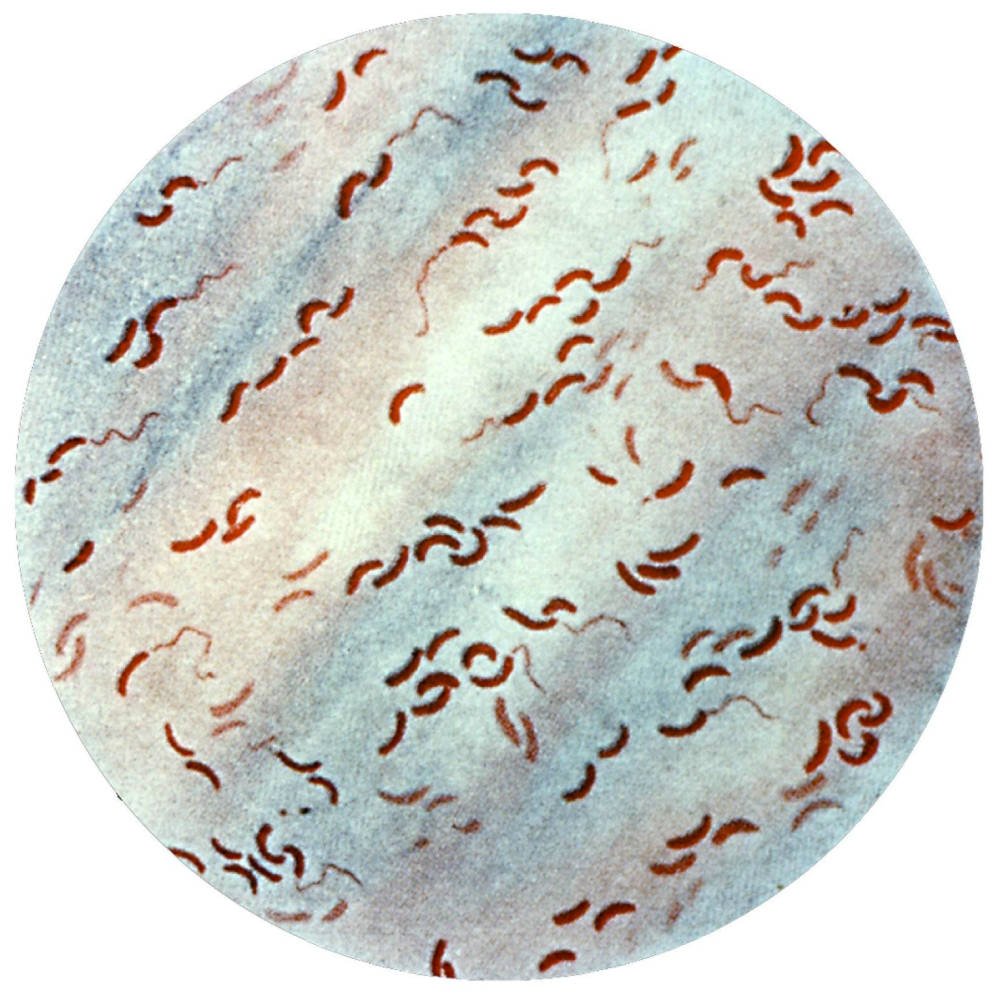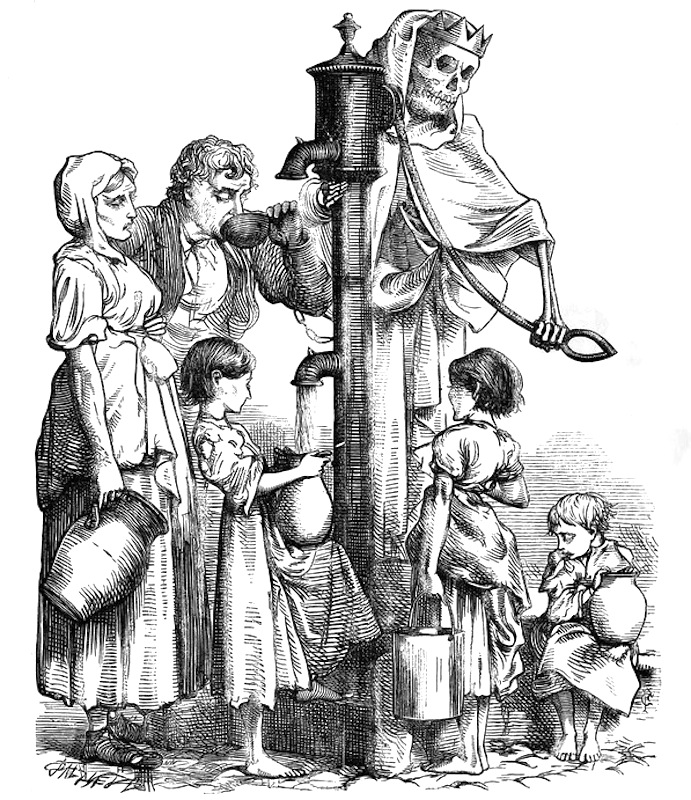This review is reproduced here by kind permission of the online inter-disciplinary journal Cercles, where it was first published. The original text has been reformatted and illustrated for the Victorian Web. Click on the images for larger pictures, and for more information where available. — Jacqueline Banerjee

Of all the epidemic diseases that threatened nineteenth-century Britain, it was cholera with its rapid and violent assault on the body that was the most feared. The period saw four major epidemics: 1831-32, 1848-49, 1853-54, with the last in London's East End in 1866. Rather than isolated events they were part of global pandemic outbreaks. Although not her first popular history of cholera, the need to understand how the disease spread to Britain, and how endemic cholera became epidemic, informs Thomas's hypothesis in this book: that the arrival and spread of cholera was facilitated by boats, ships and barges transporting people and goods along waterways. She combines this proposition with a clear statement of the importance of integrating environmental factors in understanding cholera epidemics.

The Komma Bacillus of Cholera.
While historians have examined in detail how contemporaries thought about the urban environment and cholera, in the final chapter of Cholera: The Victorian Plague, Thomas engages with theories about cholera's resurgence in the twentieth century. Contemporary work on epidemiology, DNA and cholera, and findings from the 2010-14 cholera epidemic in Haiti, offer ways for Thomas to substantiate her hypothesis. In contrasting competing late twentieth-century ideas about the nature and spread of cholera, Thomas sides with Rita Colwell, an environmental microbiologist. For Colwell cholera needs to be viewed as two separate diseases: endemic cholera, which flourishes in coastal regions, and epidemic cholera, which only occurs inland. Colwell's re-definition of cholera offers Thomas a model for answering the question at the heart of Cholera: whether or not during an epidemic, endemic cholera became pathogenic because of an environmental trigger or because an external strain was introduced. Colwell's work "suggests" to Thomas how Victorian cholera epidemics spread along waterways as endemic cholera bacteria in coastal and estuarine areas interacted with external pathogenic strains brought in by boats to create a "more toxic form of the disease" (202). Evidence is provided earlier in the book to support these claims about the importance of waterways. Yet how much we as historians can learn from modern epidemiological studies remains unclear: when they are applied to past epidemics, which occurred in different contexts, the findings can only, at best, be "suggestive." Indeed, throughout Cholera: The Victorian Plague, Thomas is often in the position of having to suggest through an imprecise language of "probably" and "may have."

Fun magazine's cartoon about the Broad Street Pump, which John Snow discovered to have been "Death's Dispensary: Open to the Poor, Gratis, by Permission of the Parish," on 18 August 1866.
Thomas is on stronger territory when describing the four major epidemics of cholera that effected Britain in the nineteenth century. Any student reading Cholera: The Victorian Plague will get a clear sense of the history of the disease; one which mixes science with social and medical history. Thomas ably blends primary and historiographical evidence to fashion her narrative. If some of the historical works she uses, such as Longmate's 1966 study King Cholera are now dated, the result is a chronological account that traces the impact of the disease; one that is attentive to social and urban conditions; to the lives of individual victims identified in official reports and newspapers; and to shifting medical debates and disagreements. Although London dominates, Thomas usefully reminds us that other English provincial cities equally need to be fitted into the narrative, especially when discussing the 1831-32 epidemic or the problems of burying cholera victims. Accounts are offered of what Thomas sees a compelling moments in the history of cholera from the arrival of the disease in Sunderland and contemporary reports of the horrors of the Infant Pauper Asylum in Tooting in south-west London, which was ravaged by cholera during the 1848 epidemic, to a discussion of poverty, urban conditions and the dangers of overflowing graveyards. For Thomas politics and political economy (what she calls philosophy) are seen as barriers to modernisation. Chapters are equally devoted to John Snow and the story of the Broad Street pump and to the development of a sanitary infrastructure as embodied in Joseph Bazalgette's London sewage system. In her account, Thomas is careful to challenge existing myths, notably Snow's sole role in asserting cholera was a waterborne disease, and to highlight tensions and competing medical views of cholera.
While Thomas shows the stories that can be told around cholera, its victims, and its medical and sanitary history, her popular history is not an unproblematic account. There is something of the magpie in Thomas's approach as she jumps from detail to detail. Not all of this detail is relevant, or shown to be relevant, which creates problems when it comes to developing a coherent argument. Medical rather than social or moral concerns dominate despite cholera generating a range of social and political debate about the urban environment and poor as demonstrated by Pamela Gilbert's excellent work. While Thomas does show to good effect how evidence from newspapers and official reports can be used, she often presents evidence at face value; for example, in highlighting a Dickensian view of the workhouse that appeals to modern readers. Judgements are made, such as about the Victorian poor not washing their hands, which lack sensitivity to the historical context. Other than the victims of cholera, male voices and a familiar cast of male actors — William Farr, Edwin Chadwick, John Snow, William Budd — dominate, not only in terms of the detail but also in terms of the evidence used. In concentrating on key moments in the history of cholera, the post-1866 history of response to the disease is given scant attention. For instance, little is said about the creation of port sanitary authorities or about the fears that subsequent pandemics engendered, which in 1893 to 1894 prompted a survey of local sanitary arrangements by the Local Government Board.
This is not to suggest that Thomas does not offer an accessible approach to the history of cholera. Thomas's fusion of science, social, and medical history might not be a complete history, as claimed, but much fascinating detail is included and the familiar "moments" in the understanding of and responses to cholera are covered in detail and with sensitivity. However, the canny students would be wise to read Thomas's book alongside Hamlin's excellent Cholera: The Biography, which offers scientific rigor and accessibility.
Related Material
- Cholera and the Komma Bacillus of Koch
- John Snow and Waterborne Diseases
- Chadwick's Report on Sanitary Conditions
- "The New and Fatal Disease" — Thomas Arnold and the 1832 Cholera
- "Cholera in England and America 1855" (see especially the last two paragraphs)
- A melancholy monument to the ravages of disease in British India
Book under Review
Thomas, Amanda J. Cholera: The Victorian Plague. Barnsley: Pen & Sword History, 2015. Hardcover. 248 pp. ISBN 978-1783463503. £19.99.
[Illustration source] "Death's Dispensary: Open to the Poor, Gratis, by Permission of the Parish," Fun. 18 August 1866. George A. Smathers Libraries. Web. 18 January 2017.
Last modified 18 January 2017